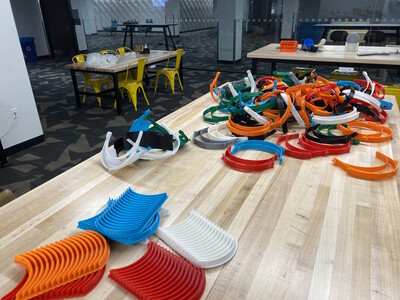
Over the last week, Surovec, the Program Coordinator for the ASU Library Makerspace, has been the only human in a space defined by collaboration, helping ASU produce hundreds, possibly thousands, of face masks and face shields, in critical short supply, for those working on the front lines of the pandemic.
“It’s a big ASU effort and I'm proud that the Makerspace is part of it,” said a sleep-deprived and socially-distanced Surovec via Zoom call on Tuesday afternoon. “I’ve got seven 3D printers going constantly. I’m in production mode.”
Working amidst a pandemic is challenging enough, but Surovec says his work is complicated further by the fact that the Makerspace was not designed for mass producing supplies but rather prototyping solutions to real-world challenges.
“All the machines are different, requiring different software, so each machine means a new project," he said. "It’s time consuming and labor intensive, but it’s all we have right now. I’m trying to find that happy medium between quality and quantity given the circumstances.”
The Makerspace is just one of many ASU units that has been repurposed to help combat COVID-19.
Surovec, who has been riding his bike to campus every day to get some fresh air and keep his spirits up, sees libraries as unique, collaborative spaces where maker culture can thrive. He says he’s looking forward to a time when the ASU community can come back together again in the same space.
“The strength of the Makerspace is collaboration, where you tackle a problem together, and doing this in a space where you have access to all the needed stuff, the tools, the resources," he said. "It enables us to do things in a cleaner, more creative and efficient way. But, right now, we just have to get these supplies out to the medical field.”
That’s top priority, he said.
Victor Surovec has been making stuff his whole life. He holds a BFA in Sculpture from Arizona State University and has more than a decade of experience working in makerspaces, where he has taught everything from woodworking to 3D printing, to learners of all ages, from 12 to 80. He is interested in the connections between project-based learning, community collaboration and the creative spaces that support innovation.
By Britt Lewis

